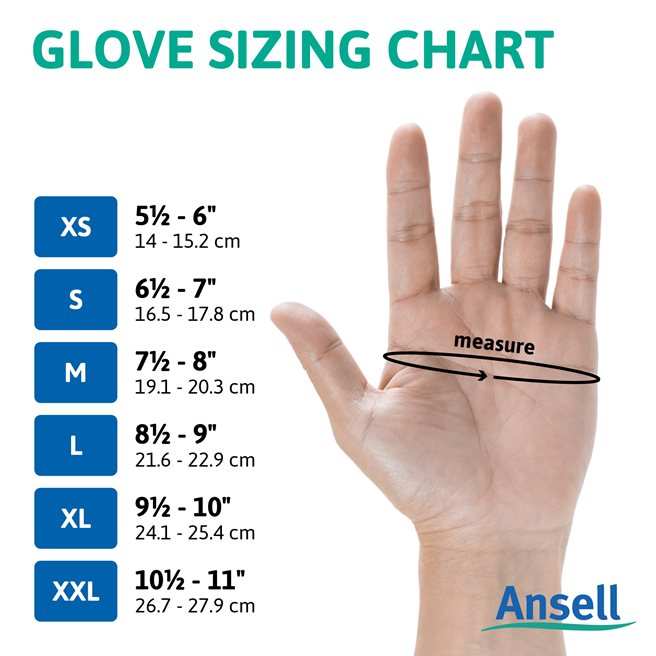Selecting the right glove size is crucial for comfort, functionality, and overall hand protection. Ill-fitting gloves can lead to discomfort, reduced dexterity, and even compromise safety in various activities. This guide will take you through the process of measuring glove size in the UK, providing insights into the importance of accurate sizing, understanding the variations in sizing standards, and offering practical tips to ensure you find the perfect fit.
Choosing the correct glove size goes beyond mere comfort; it is a key factor in ensuring the gloves serve their purpose effectively. Gloves that are too tight can restrict movement and cause discomfort, while those that are too loose may compromise their protective function. Whether you’re selecting gloves for work, outdoor activities, or fashion, having the right size is essential for a positive and functional experience.
Prerequisites for glove measurement
Accurate glove measurement is crucial for optimal comfort, dexterity, and functionality. Before you embark on the measuring process, ensure you have the following prerequisites in hand:
Measuring Tools:
- Flexible Measuring Tape: A flexible measuring tape is the ideal tool for accurately measuring hand circumference and finger lengths. Its flexibility allows it to conform to the curves of your hand, providing precise measurements.
- Alternative (Optional): If you don’t have a measuring tape, you can use a non-stretchy string or ribbon. Wrap it around your hand and fingers, mark the point where it meets, and then measure the marked distance against a ruler.
Additional Considerations:
- Helping Hand: While not essential, having someone assist you with the measuring process can ensure greater accuracy, especially for individuals with limited dexterity.
- Noteworthy Time: Ideally, measure your hands later in the day, as they tend to swell slightly throughout the day. This ensures a slightly looser fit that accommodates potential swelling during use.
- Writing Utensil and Paper: Having a pen and paper handy allows you to note down your measurements for easy reference when selecting your gloves.
Different types of gloves
Gloves are essential accessories that serve various purposes across different industries, activities, and climates. This comprehensive overview explores the diverse array of glove types, each designed to meet specific needs, from protection and safety to style and comfort.
Medical Gloves: Safeguarding Health in Clinical Settings
Medical gloves are pivotal components of infection control in healthcare settings. Designed to maintain a sterile environment and protect both healthcare professionals and patients, these gloves come in various types, such as latex, nitrile, and vinyl. Latex gloves offer a snug fit and high tactile sensitivity, while nitrile gloves are an excellent alternative for individuals with latex allergies.
Work Gloves: Essential Tools for Occupational Safety
Work gloves are the unsung heroes in the realm of manual labor, providing protection and enhancing performance across diverse industries. Leather work gloves are a classic choice for their durability, making them suitable for construction and heavy-duty tasks. Cut-resistant gloves, often crafted from materials like Kevlar, offer a shield against sharp objects, while chemical-resistant gloves are essential for handling hazardous substances.
Fashion Gloves: Elevating Style with Functional Elegance
Fashion gloves seamlessly merge style with functionality, adding a touch of sophistication to outfits while offering protection from the elements. Leather fashion gloves exude timeless elegance, often chosen for formal occasions. Knit or fabric gloves, trendy and versatile, are popular for casual wear, especially in colder seasons.
Winter Gloves: Shielding Against Cold with Style
Winter gloves are essential accessories designed to keep hands warm and protected during colder months. Insulated gloves, equipped with materials like Thinsulate, retain warmth without sacrificing dexterity. Waterproof gloves are crucial for wet and snowy conditions, ensuring hands remain dry and comfortable.
Step-by-Step Guide to Measure Glove Size in the UK
Emphasizing the significance of a proper fit to avoid common issues associated with ill-fitting gloves, the guide covers essential aspects such as understanding UK sizing standards, variations across brands, and the conversion of measurements to glove sizes. It walks readers through the process of gathering materials, using proper tools, and ensuring accuracy in measurements.
Hand Measurement Technique
Accurate hand measurement is crucial for finding the right glove size. Follow these steps to measure your hand:
- Using a Tape Measure:
- Unroll the tape measure and ensure it is straight and not twisted.
- Place one end of the tape measure at the base of your palm, where your hand meets your wrist.
- Wrap the tape measure around your hand, ensuring a snug but not tight fit.
- Take note of the measurement at the point where the tape meets the starting end.
- Identifying Key Measurement Points (e.g., Palm Width, Finger Length):
- Measure the circumference of your hand at its widest point, typically across the knuckles.
- Measure the length of your fingers from the base to the tip.
- Note any additional measurements that may be relevant based on the glove style, such as wrist circumference for gauntlet-style gloves.
Conversion to UK Glove Sizes
Once you have your hand measurements, it’s time to convert them to the appropriate UK glove size. Most glove manufacturers provide sizing charts that correlate measurements to glove sizes. These charts often include ranges to accommodate variations in hand size.
- Understanding Sizing Charts:
- Locate the sizing chart provided by the glove manufacturer.
- Identify the measurement ranges for each glove size.
- Match your hand measurements to the corresponding size on the chart.
- Interpreting Measurements for Accurate Sizing:
- If your measurement falls between two sizes, consider your personal preferences and the intended use of the gloves.
- For a snug fit, choose the smaller size within the range.
- If you prefer a roomier fit or plan to wear additional layers underneath, opt for the larger size.

Image source: ansell.com
Tips and Considerations
Taking Into Account the Type of Gloves (e.g., Work Gloves, Winter Gloves)
Different types of gloves may have specific sizing considerations based on their intended use and design. For example:
- Work Gloves:
- Consider the level of dexterity required for your tasks.
- Work gloves with precision tasks may benefit from a snug fit, while general-purpose gloves may allow for a bit more room.
- Winter Gloves:
- Account for the potential need to layer underneath.
- Ensure the gloves provide enough insulation without compromising mobility.
Considering Personal Preferences (Snug Fit vs. Roomier Fit)
Your personal preferences play a crucial role in selecting the right glove size. Some individuals prefer a snug fit for enhanced dexterity, while others may opt for a roomier fit for comfort and ease of movement. Understanding your preferences will guide you in choosing the size that aligns with your comfort and performance expectations.
Seeking Assistance if Unsure About Measurements
If you find the measurement process challenging or are unsure about interpreting sizing charts, don’t hesitate to seek assistance. Many glove manufacturers and retailers provide customer support to help you navigate the sizing process. Additionally, reading customer reviews can offer valuable insights into how specific glove models fit and whether users recommend sizing up or down.
Troubleshooting
Common Mistakes in Measurement
Accurate measurement is paramount when determining glove size. Understanding and avoiding common mistakes can ensure precision:
- Incorrect Placement of the Tape Measure:
- The tape measure should start at the base of your palm and follow the natural contours of your hand.
- A misaligned tape may lead to inaccurate measurements.
- Not Accounting for Finger Length:
- Neglecting to measure the length of your fingers can result in gloves that are too short or restrict movement.
- Inconsistent Measurement Pressure:
- Maintaining a consistent pressure during measurement ensures an accurate representation of your hand size.
- Avoid overly tight or loose measurements that can impact the final glove fit.
Adjusting for Specific Glove Styles
Different glove styles may require specific adjustments during measurement:
- Work Gloves:
- Consider the level of dexterity needed for tasks.
- Precision tasks may necessitate a snug fit, while general-purpose gloves may allow for a bit more room.
- Winter Gloves:
- Account for potential layering underneath.
- Ensure the gloves provide sufficient insulation without compromising mobility.
- Gauntlet-Style Gloves:
- Measure wrist circumference if the gloves have a gauntlet style.
- Ensure the gloves cover the wrist adequately for added protection.
Dealing with In-Between Sizes
Encountering measurement results that fall between two sizes is common. Here’s how to handle this situation:
- Consider Personal Preferences:
- If you prefer a snug fit, opt for the smaller size within the range.
- For those who prefer a roomier fit or plan to wear additional layers, choose the larger size.
- Refer to Brand-Specific Recommendations:
- Some brands may guide whether to size up or down if measurements fall in between.
Where to Find Glove Size Information
Checking Brand Websites:
- Most glove manufacturers include detailed sizing information on their websites.
- Explore size charts, guides, and any additional tips provided by the brand.
Utilizing Sizing Guides in Stores:
- Physical stores often provide sizing guides or charts near the glove displays.
- Take advantage of these resources for on-the-spot assistance.
Seeking Advice from Customer Reviews:
- Customer reviews can offer valuable insights into how specific glove models fit.
- Look for comments from individuals with similar hand sizes and preferences for more personalized guidance.
Conclusion:
Mastering the art of measuring glove size in the UK is the key to unlocking comfort, protection, and optimal functionality. By understanding the nuances of UK sizing standards, utilizing the right tools, and following a systematic approach, you can ensure a perfect fit for various glove types, be it for work, fashion, or winter activities.
Accurate measurements, coupled with considerations for specific glove styles and personal preferences, empower you to make informed choices. So, measure confidently, explore sizing guides from reputable brands, and dive into customer reviews for additional insights. Remember, a well-fitted glove not only elevates your overall experience but also safeguards your hands in style. Happy measuring!
Frequently Asked Questions (FAQs)
To find your glove size, grab a flexible tape measure and wrap it around your hand at its widest point, excluding the thumb. Take note of the measurement in inches, rounding up if needed. Check brand sizing charts for a precise match.
A hand measurement of 7 inches typically corresponds to a glove size small or medium, but it’s crucial to consult the specific sizing chart provided by the brand to ensure an accurate fit.
A glove size of 9.5 generally indicates a larger hand size. However, refer to the brand’s sizing chart for detailed information, as sizing can vary between manufacturers.
Size 4 in gloves is a relatively small size, suitable for children or individuals with petite hands. Ensure to check the brand’s sizing chart to match the size accurately and guarantee a comfortable fit.
